78 RPM Sephardic Recordings
1906-1913: The First Recordings
Commercial Sephardic recording began in 1906 or 1907 in
Constantinople, when Salomon Effendi
(Salomon Algazi) recorded
Noche Buena ♪
for the Odeon Record company. (1) In a burst of activity from 1906 to
1913, four companies recorded nearly 215 Sephardic songs, laying down
most of the early masters known to us.
Odeon
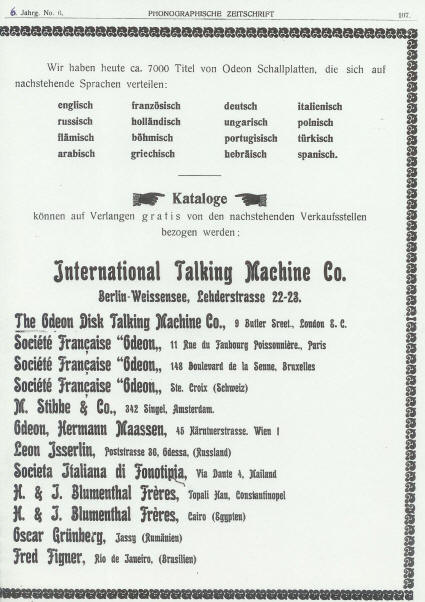 The International Talking Machine Company
(Odeon)
was the first company to institute a system of independent agents who
worked with local artists to record local music. (2) By 1905
Odeon had amassed a catalog of hundreds of Arabic, Greek and Turkish songs.
(3) In comparison, over the next
six years Odeon released roughly two dozen double-sided Sephardic
recordings, overwhelmingly in Judeo-Spanish rather than Hebrew. Their
recording artists included
Jacob Algava,
Albert Beressi,
and the club singer Haim Effendi. This
limited slate of releases indicates the relatively small commercial
opportunity presented by Sephardic music. The International Talking Machine Company
(Odeon)
was the first company to institute a system of independent agents who
worked with local artists to record local music. (2) By 1905
Odeon had amassed a catalog of hundreds of Arabic, Greek and Turkish songs.
(3) In comparison, over the next
six years Odeon released roughly two dozen double-sided Sephardic
recordings, overwhelmingly in Judeo-Spanish rather than Hebrew. Their
recording artists included
Jacob Algava,
Albert Beressi,
and the club singer Haim Effendi. This
limited slate of releases indicates the relatively small commercial
opportunity presented by Sephardic music.
Gramophone
Odeon's arch-rival, the Gramophone Company had been the first to record in the
Ottoman Empire, in 1900. In May of that year, the Gramophone engineer
William Sinkler Darby visited Belgrade and Bucharest, then recorded
Greek and Turkish songs in Constantinople on single-sided, 7-inch
records. (4)
Around 1907, Gramophone
opened a regional office in Alexandria.
This
office handled the company's affairs for the Near East, and issued
the Greek and Turkish catalogues, including many of the so-called
"Oriental Jewish" recordings discussed here. (5) Gramophone too built up quite a catalog of Turkish, Greek and other
material before turning its attention to Sephardic recordings.
In 1907 Gramophone engineers went to Sarajevo and Constantinople, recording
masters that quickly found their way onto almost 30 releases. It's
surely no coincidence that Gramophone
added their first Sephardic titles shortly after Odeon did. The same
artists often recorded for several companies; for instance, Jacob Algava
recorded for both Odeon and Gramophone. It was also impossible to disguise
the very bulky equipment and supplies that recording engineers
carried in those days. So Gramophone representatives would
certainly have known of Odeon's Sephardic activities in advance of the
release date.
After a
two-year break, visits by Gramophone engineers to Salonica in March 1909
and Smyrna the following month yielded a new crop of recordings,
including the first by the famed cantor
Isaac Algazi.
Off the beaten track, the
expatriate Italian singer and Hazan
Alberto
della Pergola recorded four
Hebrew sides for Gramophone in Bucharest, Romania ca. August, 1913.
Some
of these Gramophone Company titles appeared on the Gramophone label,
while others were released by the
Zonophone "budget" label.
With recordings originating in Bucharest, Constantinople,
Salonica, Sarajevo and Smyrna (Izmir) (6), the Gramophone
Company had by
far the largest roster of Sephardic artists and recording locales.
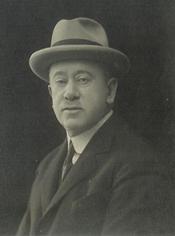 Orfeon Orfeon
The first Turkish record company was founded in
late 1910 or early by the brothers Julius (pictured here)
and Hermann Blumenthal. Born in the Levant to Russian parents, the Blumenthals had previously served as local
agents for Odeon (7) (See also the advertisement, above, both courtesy of
Hugo Strötbaum.)
Shortly afterward, the brothers opened Turkey’s first record factory,
in Feriköy. They wasted no time addressing the Sephardic market in the
Ottoman Empire, releasing 45 songs by the prolific
Haim
Effendi from 1911 to 1913 on their
Orfeon and Orfeos labels. In
addition to Sephardic releases, the mainstay of the company was Turkish
music. The firm contracted "with many of the outstanding artists of the
period, foremost among whom was Tanburî Cemil Bey, as well as Hafız Âşir, Hafız Osman,
Arap Mehmet, Hanende İbrahim and Tamburacı Osman Pehlivan." In
1925, the firm sold its factory to Columbia, and re-releases
were subsequently issued on that label. (8)
Haim's recordings had an incalculable impact on Sephardim, extending
to versions of the songs collected by far-flung folkorists such as
Alberto Hemsi, Moshe Attias, Léon Algazi and Isaac Levy. "Many of these
items became standard pieces of the contemporary repertoire..." (9)
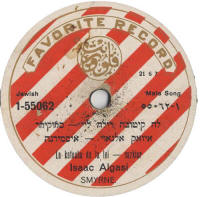 Favorite Favorite
Favorite, a German record company rounded out the field of early
entrants, with 14 songs recorded in 1912 and 1913 in Izmir, including
ten by Isaac Algazi. Though small, Favorite was an important competitor
in the Levant. Paul Blumberg, a Gramophone Company representative based in Izmir, wrote the Alexandria office in 1911, "The Favorite when
quite a small company was able to make records in February, and now
for the second time, whereas we, the great Gramophone Company, after
some two years, are meeting with all kinds of difficulties and
unpleasantness on account of a few records." (Emphasis in the original.)
(10)
The company also recorded
operettas, as well as Greek and Armenian records, and is especially
noteworthy for its recordings of artists from Izmir and Salonica. (8)
The initial repertory from these four companies was
overwhelmingly in Judeo-Spanish. Over time, Judeo-Spanish continued to
predominate, but substantially more Hebrew selections entered the
market.
Sales figures
The scarcity of surviving recordings suggests the question of how widely they were marketed. Aside from copies in record
company archives, I know of only a handful of records remaining from the entire
output of the Gramophone and Favorite companies from this early period.
Each disk likely sold at most a few thousand copies or less. (11) I
consider it most likely that only Sephardim purchased these recordings.
(12)
1914-1923:
Haim Effendi on Orfeon
For the next ten years the only recordings were made by Haim Effendi
for the Orfeon label. (See [13] for the only exception.) While
his first batch of recordings favored Judeo-Spanish over Hebrew two to
one, this next round of recordings almost exactly reversed that ratio.
Of course, World War I cast a pall over the
industry worldwide. But following the war, the 1920s were boom times for
music sales and recording activity, including other vernacular music.
But not for Sephardic music.We are left to speculate whether sales were
too modest, or if public tastes remained constant enough that no new
recordings were commercially required. Also, the wave of consolidation
that swept the European record industry meant that the surviving firms
had their pick of the recordings in the vault. In any event, there was
very little Sephardic recording activity at a time when fresh Greek,
Turkish and Balkan recordings were certainly commissioned. (14)
Haim would make only a handful of additional Sephardic recordings in his
career. As our story continues, it moves from the Ottoman lands to New
York City.
1924-1929:
New Labels and
Re-Releases
New York
The
Palomba Record and Talking Machine Co. issued one recording around
1923, with arrangements by Morris Cazes & Louis Matalon and vocal solo
by Isaac Angel. Within a year, Angel had his own boutique label, the
Angel Record Company and issued at least one more recording,
a version
of
La vida do por el raki.♪
A few more New York releases came to market. For example, both
Menachem Tsarfati and Morris Cazes (see above and the Stamboul
Quartette, below) recorded at about the same time time. I have not
been able to unearth any details.
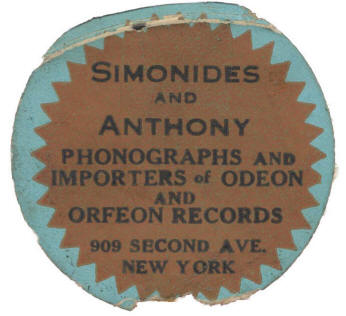 Sephardic recordings were offered for sale
at many New York City venues: the Balkan Phonograph Store, the International Phonograph Co.,
Simonides and Anthony and others. See
here for details and the advertisements. Sephardic recordings were offered for sale
at many New York City venues: the Balkan Phonograph Store, the International Phonograph Co.,
Simonides and Anthony and others. See
here for details and the advertisements.
In 1925
Columbia Records
issued the first and only Sephardic 78-rpm
recordings by a major US label: two
12" releases by the
Stamboul Quartette, whose personnel included the
previously mentioned Isaac Angel and Morris Cazes. All four songs were in Hebrew. These US
recordings do not differ appreciably from their European
counterparts in performance style. Though no one can match Isaac
Algazi's interpretive prowess, contrast
this version ♪ of Avinu Malkeinu
by the
Stamboul Quartette with
this one ♪ by Algazi.
European labels
In
late 1926 or 1927, Polydor recorded
Elias Béhar on a two-sided
Judeo-Spanish 78, accompanied by violin, 'oud
and piano (Sample.
♪) This is the first known use of a piano in a Sephardic
recording.) About the same time, the
Edison Bell
Penkala company was recording Carselero i Piadoso by Stella in Zagreb.
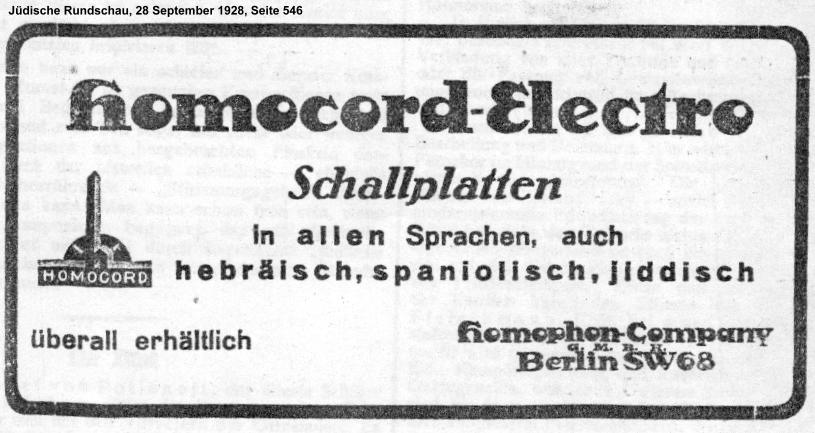 A tantalizing 1928
advertisement for Homocord touts the company's Hebrew, Yiddish and
Judeo-Spanish recordings (Courtesy of Dr. Rainer E. Lotz.) A tantalizing 1928
advertisement for Homocord touts the company's Hebrew, Yiddish and
Judeo-Spanish recordings (Courtesy of Dr. Rainer E. Lotz.)
Della Pergola, Albert
Pincas and possibly other artists recorded Hebrew Sephardic songs for Homocord.
Aside from the Pincas titles,
I am still seeking out further details.
In
1929 Isaac Algazi made five disks of Judeo-Spanish songs for the French
company Pathé, in addition to other Turkish works. He also completed seven
discs for Odeon.
From here forward, virtually all Sephardic
songs marketed in Europe resulted from re-releases.
Re-releases
The German branch of the Gramophone Company, Deutsche Grammophon, was
confiscated as enemy British property on April 24, 1917 and sold to
Polyphon. At war's end, unable to use the Gramophone or HMV trademarks, Polyphon issued Gramophone recordings on the Polyphon and
Polydor labels (15) Among these were eight Gramophone
Company recordings released on Polyphon sometime between the end of
World War I and fall, 1922.
Through 1931
the European recording industry underwent a dizzying series of
bankruptcies, consolidations and overseas ventures. I will try to
distill a very complex situation by discussing only those business
changes that facilitated the re-release of Sephardic recordings.
In 1913,
Favorite was folded into the Carl Lindström
A.G. family of labels. In 1920 the General Phonograph Corporation
acquired the Carl Lindström
catalogs, including Odeon and Favorite. From 1921
onward, General Phonograph Corporation drew on European masters to
produce recordings on its newly formed American Odeon label. (16) American Odeon produced a series of 16 Sephardic Odeon
re-releases, from recording sessions originally dating from 1907 and
1908, all issued by the summer of
1926. (See the catalog here.)
In 1926, Odeon and other Lindström
labels were sold to the Columbia Graphophone Co. in England and
became part of the Columbia business
in Europe. (17) After 1930, European Odeon matrices appeared for several years on
Columbia. For example, at least one
Favorite Sephardic recording was re-issued on the
Columbia label.
In a huge 1931 merger, the
Columbia Graphophone Company (which by then owned Odeon,
Favorite and many other labels) joined with the Gramophone company to
form Electric and Music Industries Ltd. (EMI). Orfeon masters
were reissued on Columbia sometime by the late 1930s.
1930s:
Art-Song Renditions
By the 1930s the global economic contraction and
the impact of radio and talking pictures hurt phonograph and record
sales dramatically (18) There were only a handful of new European recordings
dating from the 1930s, In Europe,
Léon Algazi arranged
Sephardic songs in Hebrew (sung by
Léon Gerberg ♪) and
in Ladino
(sung by
Janine Tenoudji ♪)
Albert Pincas recorded for the Ultraphon label, though
we have no release details.
(19) And the Jewish settlement in Palestine, in the person of Bracha Zefira, contributed
its first Sephardic recordings.
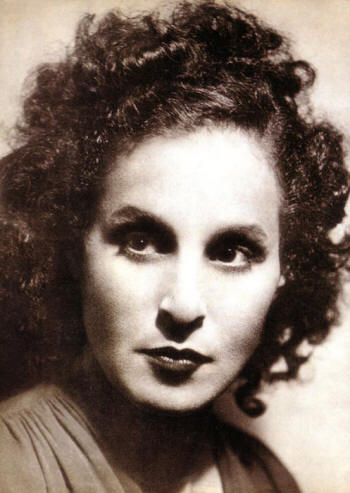 Bracha Zefira Bracha Zefira
Born of Yemenite parents and orphaned early in life, at the age of six Zefira
was taken in by a Sephardi widow. She heard her first Judeo-Spanish
romances from the women of the Yemin Moshe neighborhood. She later learned traditional
Sephardic songs from both Alberto Hemsi and Yitzhak Navon. Zefira
concertized extensively in the early 1930s and several Israeli composers
later arranged her song choices. (20)
Zefira's extensive public performances introduced the wider
Israeli public to Sephardic songs for the first time, and it was
squarely in an art-song, "a la Franka" (Western) style (21) Her recordings were
mastered from 1937 onward. A handful of her Hebrew Sephardic works were issued on
78, such as
Ein Adir
♪.
Various Ladino songs she performed were also set to Hebrew words, such
as Yendome (transformed into
Yesh Li Gan ♪) and
Mama yo no tengo vista, which became
Hitrag'ut. These songs and others helped form the core
of the modern Israeli Sephardi canon. (22)
It's worth noting that both these trailblazers, Bracha Zefira and
Léon Algazi,
were intimately familiar with the tradition they were adapting.
1941-1954: The End of the 78 Era
As Europe erupted in war, virtually all Sephardic
recordings of the 1940s were made in North America. And since major US
labels withdrew from the ethnic music field, it was smaller independent
labels that moved in to fill the breach. (23)
In New York, dozens of Greek-owned nightclubs on 8th Avenue from 23rd
to 42nd
street served as a haven for Greek and Armenian immigrants – as well as
Sephardim originally from the region. On stage, Albanian, Armenian,
Greek, Sephardic and other vocalists and session musicians all
contributed to the flavorful melange. Several record companies sprang up
devoted to these musicians and their audiences.
According to one account, Me-Re was
established in the early 1940s by Aydin Asllan (a poly-lingual Albanian)
and the violinist, Nick Doneff. They soon parted company, with Aydin
founding Balkan and Doneff founding Kaliphon Records. (24) Whatever the
(cross-) ownership among the Balkan, Me-Re,
Metropolitan and
Kaliphon labels, artists moved fluidly from label to label: 'Oud player
Marko Melkon recorded for all four labels, while
Victoria Hazan (see below) recorded for Metropolitan and Kaliphon.
Jack Mayesh
and Victoria Hazan
Jack Mayesh and
Victoria Hazan were the last in a
line of Sephardic artists who grew up with, performed and recorded in
the idiom of urban Ottoman music. As was characteristic of many of their
predecessors, they operated comfortably in multiple languages, and
actively set songs from other traditions to Judeo-Spanish
lyrics.
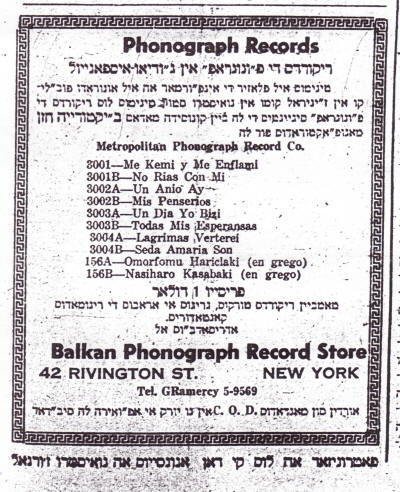 Fluent in several languages,
Victoria Hazan recorded in
Turkish, Greek and Judeo-Spanish.
Metropolitan released five of
her Judeo-Spanish recordings in early 1942, accompanied by violin, 'oud
and kanun. (See illustration at right.) Here is
El Cante por la Victoria ♪,
surely the only Ladino song to reference both Uncle Sam and Hitler!
(Lyrics here.) Fluent in several languages,
Victoria Hazan recorded in
Turkish, Greek and Judeo-Spanish.
Metropolitan released five of
her Judeo-Spanish recordings in early 1942, accompanied by violin, 'oud
and kanun. (See illustration at right.) Here is
El Cante por la Victoria ♪,
surely the only Ladino song to reference both Uncle Sam and Hitler!
(Lyrics here.)
Jack Mayesh made nine recordings for his own
Mayesh Phonograph
Records label from late 1941 to late 1943, accompanied by Gabriel Yohai on kanun. (These
recordings were mastered at the Electro-Vox studio in Los Angeles
and were occasionally released with Electro-Vox labels.) Roughly half the songs were in
Hebrew, and half in Judeo-Spanish. During
a New York excursion in summer, 1948, Mayesh made three more recordings
for Me-Re (which bear Balkan matrices), all in Judeo-Spanish. These
latter recordings had more elaborate accompaniment, an "Oriental
Orchestra" led by Theodore Kappas on kanun, with violin and 'oud.
According to his son, these were the best and most popular of his
secular recordings. (26)
For their secular works, both Mayesh and Hazan drew
on well-known Greek and Turkish folk and urban songs, which they then
set to Judeo-Spanish lyrics. For example, Mayesh did his own version of
Missirlu ♪ and transformed a song first known in Turkish as Benim
güzel bülbülüm then in Greek as Kanarini into
Ven
canario. ♪
(25)
The Spanish and Portuguese catalog was bolstered by releases from
London's Bevis Marks choir
and Congregation Shearith Israel in Manhattan. The latter released
a double-78 of
five Hebrew songs from the music of the congregation with Dr. David
de Sola Pool and the synagogue choir. 1951 saw the release of the first
recordings of Sephardic field recording. Six Judeo-Spanish songs
recorded in Paris by a couple from Salonica were included as part of a
larger U.N.E.S.C.O. album.
(Here is Ana Angel singing
Partos Trocados.♪)
Two Makolit Israeli 78s of Sephardic songs as set by the cantor
Nissan Cohen Melamed and performed by
Benjamin Misrakhi
close out the Sephardic 78
era.
Summing Up the 78 Era
At the turn of the past century there was an exuberant expansion of
the repertoire coupled with relatively little experimentation in
performance practice. We need further research to determine if
performances in Salonica, Sarajevo
and elsewhere differed significantly from practices in
Constantinople, the city where most Sephardi commercial master
recordings originated.
Curiously, many prominent Sephardic recording
artists did not record Hebrew or Ladino repertory. Most notable
by her absence was Rosa Eskenazi,
(27) but Abraham Caracach
Effendi, Misirli Udi Avram (a.k.a. Samli Avram Effendi),
Pepron Hanim and Bey Neuman, among others, did not
record Sephardic songs either.
In 1957 Professor Curt Sachs famously defined
Jewish music as music "by Jews, for Jews, as Jews." (28) Sephardic 78 r.p.m.
recordings were surely "by Sephardim, for Sephardim, as Sephardim."
By Sephardim:
Nearly all the vocalists were Sephardim, and I believe that non-Jewish
vocalists were at least conversant with Judeo-Spanish.
For
Sephardim: These
recordings were bought overwhelmingly by Sephardim. (11) The repertoire
exemplifies the then-current interests of the community, enriched by
performers who actively converted folk and popular songs of their host
countries into Judeo-Spanish.
As Sephardim:
The songs were typically learned orally from other Sephardim (or from
recordings that circulated narrowly in the community) and
delivered in keeping with the performance practices of urban Ottoman
music of the time.
Of course, this definition was completely swept away in the second
half of the 20th century. Sephardic
communities that might have nurtured traditional artists were
ravaged by World War II and
subsequent dislocation and assimilation. Meanwhile, the
folk music
revival, the early music movement's "discovery" of Sephardic music and
the world music boom all led to tremendous changes in repertoire,
performance and commercial practices.
|
